In this episode, host Vanda Felbab-Brown speaks with Dr. Nicole Gastala and Dr. Harold Pollack about the challenges in reducing opioid use disorder in the U.S. They discuss the effectiveness of medication-assisted treatment and explore barriers like stigma, socioeconomic disparities, rural access issues, and insufficient insurance coverage. The conversation emphasizes the need to expand Medicaid, build family support, and reduce stigma within the medical community.
- Listen to The Killing Drugs on Apple, Spotify, or wherever you like to get podcasts.
- Watch episodes on YouTube.
- Learn about other Brookings podcasts from the Brookings Podcast Network.
- Sign up for the podcasts newsletter for occasional updates on featured episodes and new shows.
- Send feedback email to [email protected].
Transcript
[music]
FELBAB-BROWN: I am Vanda Felbab-Brown, senior fellow at the Brookings Institution. And this is The Killing Drugs. With more than 100,000 Americans dying of drug overdoses each year, the fentanyl crisis in North America, already the most lethal drug epidemic ever in human history, remains one of the most significant and critical challenges we face as a nation. In this podcast and its related project, I am collaborating with leading experts on this devastating public health and national security crisis to find policies that can save lives in the United States and around the world.
On today’s episode, I am exploring demand reduction measures. My guests are Doctor Harold Pollack, the Helen Ross Professor at the Crown Family School of Social Work, Policy, and Practice at the University of Chicago, and Doctor Nicole Gastala, the medical director of the Substance Use Prevention and Recovery Division of the Illinois Department of Human Services and the director of Behavioral Health and Addiction at the Mile Square Health Center at the University of Illinois, Chicago. Thpeir project paper, co-written along with Doctor Basmattee Boodram, Doctor Mai Pho, and Doctor Mary Beth Shapley, is titled “Demand Reduction Measures to Address the Opioid Epidemic.”
Harold and Nicky, thank you very much for joining me.
POLLACK: Thanks for having us.
GASTALA: Thank you so much.
FELBAB-BROWN: Harold, first of all, please explain to us what is demand reduction for illicit drug use? That is, drug use without medical authorization.
[1:48]
POLLACK: So, demand reduction is really reducing substance use and particularly reducing problematic substance use and substance use disorders. And that’s a tall order. There’s really several elements to that. One is primary prevention—to prevent people from developing problematic use or substance use disorders in the first place. It also includes substance use disorder treatment to help people reduce their use and sustain their recovery.
And in the case of some substances, for some people, in some circumstances it may also include things like legal pressure to curb problematic use. Particularly, for example, if someone is in a problem-solving court because their substance use is leading to public safety issue for other people.
FELBAB-BROWN: So, Nicky, let me ask you, how many people are there in the United States who have opioid use disorder and who are in treatment?
[2:39]
GASTALA: Yeah. So, that’s a really good question. We hear about this as an opioid epidemic, but what are the actual numbers of individuals that are impacted? And researchers found that in 2021, there are about 2.5 million people 18 and older who had an opioid use disorder in the past year. But only about 36%—so, that’d be about 900,000—received any substance use treatment. And only 22%—so, that’s only about half a million—received medications for opioid use disorder. And we know that medications for opioid use disorder are evidence-based and incredibly effective in terms of curbing the morbidity and mortality crisis that we have with this opioid crisis.
FELBAB-BROWN: And, Nicky, can you just explain to us what are these medications that people are receiving?
[3:31]
GASTALA: Yeah, absolutely. So, sort of like diabetes—we have insulin, we have metformin—medicines for opioid use disorder are similar. Sometimes they come in as injectables. Sometimes they come in as an oral medication. And the three FDA approved medications that we have are methadone, buprenorphine, as well as injectable naltrexone. So, those are the three different medications that we have.
FELBAB-BROWN: And what kind of effects they have on people, how do they medically help them? Why are they so important?
GASTALA: Yeah, that’s a really great question. So, when an individual has an opioid use disorder, what we’re trying to do is impact cravings as well as withdrawal. Withdrawal is that beginning phase when they’re starting on a medication to help them control that so they don’t get shaky, nauseous, vomiting, diarrhea. So, controlling the physical symptoms.
And then cravings are the second stage. So, how do you help support someone so that they don’t feel the need or feel that craving to use? And so, these medications, particularly methadone and buprenorphine, impact both withdrawal as well as cravings. The naltrexone, the injectable naltrexone, that one only impacts cravings, not withdrawal.
And so, what these medications do is allow the person, their body and brain to heal away from substances. So, it sort of helps restabilize them, get them back into feeling more of a normal framework.
And so, with patients who are on medications for opioid use disorder, you and I wouldn’t be able to tell the difference because they’re functioning at that sort of normal level going to work, taking care of their families, interacting. And they really just help stabilize that person. And so, that’s why they’re so incredibly important, is they allow that individual’s body, mind to heal, while they work towards recovery.
FELBAB-BROWN: So, Harold, Nicky said that only half a million people are receiving medication for opioid use disorder despite the fact that medication is so important in helping people. Why is the number so low?
[5:45]
POLLACK: People with opioid use disorders face many barriers to accessing treatment. Some of those barriers are financial. Some of those barriers relate to stigma. And dealing with a medical provider who can connect them with treatment and who encourages them to go. And some of them just reflect barriers that show up in the circumstances of people’s lives and their overall life circumstances.
One thing that we do see is really large disparities based on sort of socioeconomic status and also based on race. So, the best single data source that we have is something called the National Survey of Drug Use and Health. And if anything, that probably understates some of the disparities because it’s a household survey, and it’s a lot easier in household surveys to get to people who actually respond, which tend to be more advantaged people. One of the things that they found was when they looked at people who had an indicated opioid use disorder, non-Hispanic white adults had something like 14 times the odds of actually receiving medication when compared to non-Hispanic Black adults who were responding to the survey.
Men had six times the odds of women, by the way, that’s significant gender disparities as well. And people that are full-time employed are much more likely to be engaged in treatment than other people. And I would say also—I’m sure this will come up later in the conversation—but urban-rural disparities are quite large. And being geographically accessible to a provider who can give you those medications is also very important, as of course, I’m sure many viewers and listeners are aware that many rural areas have just been hammered by the opioid epidemic, and many people in these areas have difficulty getting access to treatment.
FELBAB-BROWN: And, Nicky, who are the groups that are targeted in demand reduction measures? We have already spoken about people who have opioid use disorder. And Harold, in his opening comments, told that part of demand reduction is preventing people from developing a use disorder in the first place. But are there also other target groups that are crucial in the design of demand reduction measures?
[7:47]
GASTALA: Yeah. So, absolutely. Think about the families of individuals with substance use disorder. Addressing those needs of the family members who are impacted by the disease of their loved one, helping them understand the disease process, and helping support that individual in their engagement with evidence-informed treatment. As a family member, sometimes you want to jump immediately towards abstinence. And there’s a lot of stigma around substance use. So, having that kind understanding, but also evidence-based understanding of what your family member may need in order to be successful in their recovery. That’s one very important group.
But also thinking about the medical community. Helping to reduce addiction and addiction treatment stigma, normalizing evidence-based treatment in any area of medicine, thinking about it as we would diabetes. You can walk into the ER, you can walk into the hospital, you can walk into most primary care offices and receive treatment for diabetes. We really need to look at opioid use disorder in the same way. It is a chronic disease that does need evidence-based treatment. So, really addressing that from the medical community side.
Then you also have public and private players. So, ensuring that patients have access to treatment that is covered, that medications are within their cost recovery support, or therapy is reimbursed. And then also removing barriers such as prior authorizations to treatment or medication.
And lastly, another really important group is criminal justice leaders and staff. They are both the gatekeepers as well as the supporters of access to treatment for really millions of Americans. I have a patient, actually, who had spent the majority of his life in the justice system. And he came to me in his 70s, and he was started luckily in his recent jail stint with medications. And his whole goal was to not pass away, not die in the justice system. He had already given so much of his life to that. He wanted to be stable and recovery with his own housing and not reenter.
And really it was the understanding of the justice system that he had entered that supported his treatment, supported him in connecting to services on release, and has ultimately supported him in his recovery. And so, those are just some of the few, but there’s many important areas really that can very much impact patients’ outcomes.
FELBAB-BROWN: Well, it’s a very powerful story. And in many ways, the gentleman is lucky that he was able to have access to treatment while incarcerated. And of course, suffered tremendously in spending his life being in and out of incarceration, as you mentioned. Harold and Nicky, you are talking very much about these other target groups that many don’t think about when we think about demand reduction. We think of the individual with the substance use disorder. But your contribution is really very important in emphasizing this other wide panoply of actors.
We’ve already spoken about the fact that medication is so important, and it’s been such a long struggle in the United States to deliver medication as part of treatment. What about other demand reduction measures? Which ones work, Harold?
[11:15]
POLLACK: I think there’s a couple of different ways we need to approach this. One is to understand what are the policy structures that make it possible to deliver the treatment that we know is evidence-based? And this is where Medicaid is just so important. Medicaid expansion that was part of the Affordable Care Act and also Medicaid waivers that many states are now implementing to try to deal more effectively with the challenges that are faced.
And the thing is that if I’m a state legislator and I passed the Harold Pollack Let’s Help People with the Opioid Disorder Grant Act, which has a five-year grant, I will get high fives from everybody. But what I will not do is create organizational, institutional change. The University of Chicago Hospital, the University of Illinois at Chicago, they will not make a massive investment in something which has a five-year grant, because that will go away and then where will they be? If Medicaid says, oh, we now have a procedure code, we pay for the following methadone services, we pay for the following buprenorphine services, there’s nothing more boring to the public. But now treatment providers say, oh, I can actually hire 15 people. I can build a facility that offers this because I know I’m going to get paid.
So, the Medicaid waivers that try to help people leaving jails and prisons, Medicaid expansions that just expand Medicaid benefits throughout the states, those are absolutely critical in so many unexpected ways. Suppose you have like a drug court that’s in rural Illinois, and there’s someone who has a heroin addiction and he’s stealing things to support his addiction, and you want to put that person in a drug court rather than incarcerate that person. And the drug court says, hey, I want that person in evidence-based treatment. They can’t create a methadone program. They’re a small player in the middle of some rural area. But it turns out in states that have Medicaid expansion, it’s much more likely that there already is a methadone program that is being supported by Medicaid or buprenorphine program that’s already being supported by Medicaid, that that problem solving court can send that person to.
So, now we have a way to help that person other than locking them up or ignoring the problems that they’re having that might lead to further crime. So, Medicaid is absolutely essential as one of the keys. There’s many others. But I think that’s the single most important thing.
FELBAB-BROWN: So, you know, the absence of Medicaid expansion that you were talking about is one of the barriers for facilitating treatment, evidence-based treatment for opioid use disorders. Can you give us example of some of the others?
[13:46]
POLLACK: I would say provider stigma is a very important barrier. And I think … there’s different kinds of stigma. One kind of stigma is a very moralized form of stigma. I don’t like drug users; I think worse of these patients. I don’t want to spend my time with these patients. And we see with both opioids and stimulants, we see very high degrees of stigma, some of which, by the way, comes from the lived experience of medical providers. Doctors, nurses, social workers, people are human. If you’re, say, an emergency room doctor, there’s a lot about your experience of care delivery that can sometimes deepen that stigma.
And there’s a second kind of stigma, which is I actually don’t have anything against these people, but I don’t believe that anything that I have to offer is going to help them. And I don’t believe in the effectiveness of addiction treatment. And so, I’m not sending people to medications for opioid use disorder treatment because I just don’t believe in its effectiveness. And I think that’s also something that we have to work on. And trying to show people, give people a sense of evidence-based optimism that we have things to offer that actually do help. They’re not the cure for cancer, but they do help.
Now, I must say, I feel humbled giving that conversation because I know Doctor Gastala has a much more tactile experience with patients. But those are the things that we experience in our work.
FELBAB-BROWN: Well, Nicky, if you could give us some live examples from your practice, that would be terrific.
[15:12]
GASTALA: Yeah, I agree with Harold. Stigma is penetrating within society. We had this war on drugs. It was the drug user that was the problem. Rather than looking at it as a chronic health condition, not just from the public side and governmental side, but also from the medical side. It hasn’t been until sort of recently that the surgeon general, and we see all this evidence-based practice where the surgeon general says this is a chronic condition, this should be treated with evidence-based care, which does not include incarceration, it actually includes treatment. So, you have to change years and years of how people were treated.
Another factor is that substance use treatment tends to be sort of separate part of the medical system, not always integrated. And so, there also is a lack of familiarity with treating someone with a substance use disorder as you would any other chronic condition.
And actually, medical education is now requiring addiction and substance use disorder treatment to be encouraged and taught in medical school as well as residency. And so, those we will see that impact in years to come. But right now, it’s about getting current clinicians rained and comfortable when they haven’t been comfortable before, where there has been stigma associated, and where it has always been, well, we’re just going to refer out there. But recognizing that referring over there, that there’s not enough access. And that’s sort what we talked about in the beginning. There’s not enough access for treatment. And so, it has to be all of our problem in order to be able to address.
You know, you look at what happened with COVID. You have all of these docs who are not infectious disease, may not be ER docs, all sort of stepping up and saying, how can we impact COVID and the impact on society? And we need that same togetherness, right? for all of us really to get together and say we really need to impact this overdose crisis, this death crisis that we’re having, and ensure that we’re removing as many barriers to access to treatment and support so that we can turn this epidemic around.
FELBAB-BROWN: And Nicky, does this also apply to screening? Is there enough screening in doctors’ practices when people come for maybe general physical or specific illness to ask about substance use?
[17:35]
GASTALA: You know, that’s a great question. It’s really important. There are evidence-based tools to conduct screening in primary care offices for substance use, for alcohol, for tobacco. All of these are an important part of the preventative health care. And there are evidence-based tools, but not necessarily every practice is implementing it. And really just not thinking about just primary care, but what happens if you only access care through the ED or through an urgent care? So, really sort of impacting that way. And pediatric offices, when we think about young people who may be exposed and that whole prevention piece.
And so, really, just again, like you said, wide screening is incredibly important to not only identification, but then also opening up that conversation for prevention, because substance use does not equal substance use disorder. And so, defining that and having harm reduction conversations with patients that may potentially save their lives. Like, for example, you have a college student come in who goes to random parties and may try different things. And then do they know about naloxone? They may think that they’re taking ecstasy, but it may be contaminated with fentanyl. Do they know what fentanyl testing strips are? What they can do in order to be sort of more secure so that we prevent death. Right? That’s the ultimate first step in public health is creating awareness, empowering individuals, and preventing death related to substance use.
[19:08]
POLLACK: I also think we need to have a conversation that addresses the pain that family members and other loved ones are experiencing due to people’s substance use disorder, so that we make sure that we’re addressing their pain and the issues that people are having. But we also make sure that they’re in a conversation where they become allies for getting their loved ones into evidence-based treatment.
So, suppose I’m a 60-year-old mom and I have a 28-year-old son, he’s living with me at home and he’s selling drugs out of our apartment to finance his drug habit, or he’s doing other acquisitive crimes that that are that are harming me and the community. We need to acknowledge that this mom needs that she has real needs, that she’s being affected. She wants her son to stop using drugs, so she may send him to an abstinence-based intervention that’s not likely to work.
And one of the things that we have to do is, is to be able to help that family to say to that mom and to that son, hey, there’s a bunch of things that you’re doing that you can’t be doing. It’s causing pain to your mom and causing a real problem. You know, she could be evicted because you’re doing things in the apartment that are, that are putting her at legal risk. You, mom, please make sure that you’re sending him to a treatment … that you’re encouraging him to go to a treatment that’s likely to be effective so that if he’s going to methadone treatment or going to buprenorphine treatment, he has a responsibility to engage that treatment and not to be doing these things that we’re talking about. But that’s the best route to deal with the issues that you are having.
And one of the challenges we have in the harm reduction and treatment communities is to be culturally competent in acknowledging, yeah, there’s a lot of social harm that’s coming from substance use. There’s a lot of pain that family members and others are experiencing that is legitimate. And of course, they’re angry and in pain about that. But they have to channel that into effective responses.
FELBAB-BROWN: No, absolutely. The community approach, the whole of the medical profession, as Nicky was speaking about, and the community support, stepping up in the same way as we did in response to COVID is crucial.
Nicky, I want to ask you about other drugs than opioids, because as horrific as the fentanyl epidemic is, we have luck with opioids because we have medication for opioids. That’s not always the case with other drugs. What kind of evidence is there for best practices for treatment for other kinds of drugs, like methamphetamine?
[21:35]
GASTALA: Yeah, that’s a really good question. So, for stimulant use disorder—so, that would be methamphetamine, cocaine—there are some evidence-based treatments. One example is contingency management. And this treatment modality really focuses on your reward center. It’s not through medication, but it’s through actually patient goals. So, a patient will say my goals for this next week are to attend a support meeting, it’s to go to work, it’s to whatever it may be. And then if they meet those goals, the next week when they come in they could then be given a reward for that.
So, it follows that sort of same pathway that drugs follow, that dopamine pathway, but instead replaces it with a different kind of reward. And so, rewarding again towards that recovery. And that is one of the evidence-based treatments that we have. And contingency management works for other substances as well too.
And there was actually a recent paper published by the American Society of Addiction Medicine that actually talks about the new sort of up-and-coming potential medications that we may have for stimulant use disorder too. So, there is, I would say, hope as we continue to really investigate, and research, and put money into different substances to be able to support that.
Other substances that we do have medications for that patients may not really think about is alcohol use disorder. There are three medications that are effective for that in addition to recovery support. Tobacco use disorder. We have nicotine replacement options that are effective as well as other oral agents.
So, there are medication options depending on the type, but also really understanding how important recovery is and what that means to the individual. And when I talk about recovery, so recovery support specialists are those with lived experience who then can help support that individual. And that is another incredibly effective way to help support someone whether there’s medication or not.
FELBAB-BROWN: So, Nicky, if we can move to a bigger picture: many of the critics of existing drug policies, many of which are source countries, transshipment countries, often argue that the responsibility is with the demand countries. So, you hear from the Colombias, Bolivias, Mexicos, you Americans, if only you stop your demand, we wouldn’t be dealing with drug violence. We wouldn’t be dealing with illegal drug cultivation. With all that you’ve answered so far, what is the feasibility of radically reducing illicit drug use in the United States or elsewhere, or specifically opioid use?
[24:20]
GASTALA: So, there really is no single dramatic cure. It’s really unlikely that we can or will dramatically reduce illicit drug use. The market’s always changing. On the supply side, we see a transition from plant-based to a lab-based product. On the demand side, we see the continued human attraction to intoxicating and psychoactive substances. A lot of times we have to address social determinants of health in our country in order to be able to impact that want or need potentially to use.
But there are measures that can help. We can reduce the accompanying harm to users, their families, and communities. We can address the links between simple use and use disorder, or problematic use. And some measures that have helped include increasing treatment access, reducing treatment stigma, addressing trauma and other social determinants of health that increase the risk of substance use.
And then of course, the harm reduction measures. So, syringe service programs, naloxone distribution. All of these can play really lifesaving roles. So, the first step is sort of to impact again that overdose or death crisis through harm reduction and then supporting access to treatment. And then eventually moving towards those social programs that what can we do to in that prevention arena.
FELBAB-BROWN: And we have a whole episode dedicated to exploring harm reduction with Regina LaBelle and David Holtgrave, and as well as touched on that issue very significantly in the conversation with Alex Stevens on opioid issues and responses to them in Europe.
So, Nicky, you know, staying in the big picture now, giving the lethality of fentanyl and other synthetic opioids, the death crisis that you referred to that is so different than what we are used to in drug markets, and increasingly also the lethality of super potent methamphetamine, what progress has been achieved in the United States with respect to accessing treatment and accessing evidence-based treatment?
[26:22]
GASTALA: Yeah. So, just like you said, the lethality of this epidemic really defies description. Harold and I know many, many people who have died of opioid overdoses or related causes. In our chapter, we do talk about, though, there are reasons for optimism. We’ve seen this genuine bipartisan collaboration. Important legislation was passed under George W. Bush, Obama, Trump, and Biden. So, rather than acting under the war on drugs mentality of 30 years ago, policymakers and the public are increasingly embracing this chronic disease management model. And this is supported again by that drug policy and regulatory changes.
We don’t want to exaggerate the progress. Nationally, representative surveys still demonstrate partisan divide on public spending for treatment and harm reduction. And addiction stigma is also corrected with political partisanship. But we’ve made some real progress. With the U.S. surgeon general encouraging evidence-based treatment of this chronic health condition, we’ve seen increasing access, for example, to naloxone to reduce and reduce overdose deaths. And this has moved to become over the counter by the FDA and have had a lot of support in terms of cost and funding.
And naloxone saturation plans—they removed the X waiver, which was a requirement for a clinician to be able to prescribe buprenorphine, one of those medications that treats opioid use disorder. So, that really created a barrier.
And then also, which I think has been really incredible, are the recent changes by CSAT [Center for Substance Abuse Treatment] and SAMHSA [Substance Abuse and Mental Health Services Administration], particularly around methadone, which has allowed additional take-homes of methadone, reducing this transportation barrier, employment barriers, childcare barriers. Previously patients used to have to come in daily six days a week for the first 90 days of treatment, and that is incredibly difficult to do in order to qualify for more take-homes. Now, if you find that the patient is medically stable, they can qualify earlier for that under the decision of the medical director.
And that has really helped patients because if they have to choose between going to their job or caring for their child or family or coming in for medication daily, oftentimes they’re going to choose what’s going to help keep a roof over their head, keep them fed, and keep their family cared for. Really meeting those basic needs.
And until this recently has made it so much easier for patients so that they can continue to sort of work towards recovery, stabilize their life, addressing housing, employment, poverty, all of these things. And that has really incredibly, I think, improved and will continue to improve.
So, I think as long as the U.S. continues to focus on patients at the center and thinking about what can we do to remove barriers for them to access treatment, then we’ll continue on this path of improving access.
[29:21]
POLLACK: So, if you look at a medication like methadone, it’s quite effective as a medication. But treatment is also the human experience of getting that medication, dealing with your treatment provider and so on. And the human experience of getting methadone treatment from an opioid treatment provider has often been less than humane for people, and less than attractive for people.
And one of the things that Democrats and Republicans have cooperated on, sometimes through measures that get a lot of public attention, sometimes through things under the hood like the regulations that Doctor Gastala just mentioned from SAMHSA and CSAT, there’s a real effort to make the treatment experience more attractive, more accessible, more effective as a human experience. And I think that is very important.
And there’s a lot of effort being made to make this a more respectful experience, to deal with the very practical obstacles that people have to getting the treatment that they need. And this is really very important to connect people with treatment, because if you say it’s medication and evidence-based treatment, it is. But you also have to pay attention to how do people get it? What is that experience?
And there’s very serious attention being paid to that. And I think it’s because the opioid epidemic, it’s not about other people. One of the things that’s really striking—our team did some qualitative interviews with state legislators around the country, and it was really striking how many people talked about their children, friends of theirs, people that were very directly affected by opioid addiction, by the challenges of getting treatment, by fatal overdoses. And people, there really is a sense of urgency. How do we embrace people and get them into treatment and get them the evidence-based treatment that we know people need but that for a million reasons it’s very hard for people to practically engage and maintain? And so, I think that human element is really quite important.
FELBAB-BROWN: And in your work, in our podcast today, Harold, you very much emphasized the humanity, the compassion, the need for empathy, not simply the structural barriers such as insurance coverage, but also the human barriers, whether it’s stigma, which, of course, is the opposite of compassion or humanity, or other barriers.
Nicky, in conclusion, let me ask you, what is the way forward now? What are the most urgent, most important steps to take to encourage and enable more treatment for opioids and perhaps drug use disorders more broadly?
[31:51]
GASTALA: The most important thing is really continuing to think of the patient at the center of this—the patient, the family, the community. And how can we make this health condition as accessible to treatment as other common health conditions? If you have two patients who enter the ER, one who just survived an opioid overdose, maybe they’re given naloxone, maybe they’re given a handout on a local treatment program, but that’s usually about it. If you come in with a heart attack, you are kept overnight. They give you medicine. They ensure you have a cardiology follow-up. All of these are considered standards of care. And yet the individual who presented with the opioid overdose has much higher mortality than the person who presented with a heart attack. And yet they’re not getting all of the things that we expect or that we anticipate if someone had a heart attack.
So, really thinking of this as a chronic health condition that deserves evidence-based treatment and then removing whatever barriers we have, whether that’s payment, whether that’s access to treatment by expanding methadone and buprenorphine access, whether it’s addressing stigma. And as a country, as a community, and the health care system, and really ensuring that those patients have access to evidence-based treatment wherever they may seek treatment, and no matter where they touch the health system or the justice system or any other system.
FELBAB-BROWN: And in the episode with Regina LaBelle and David Holtgrave, we will hear about the cascade of care, identifying people with need providing care to them at various stages of their substance use disorder and hopefully recovery.
So, Nicky, thank you so much for the tremendous work that you are doing. Harold, equally to you, enormous thanks for having you on the show and having you be part of the project.
GASTALA: Thank you so much.
POLLACK: Thank you so much for having us.
[music]
FELBAB-BROWN: The Killing Drugs is a production of the Brookings Podcast Network. Many thanks to all my guests for sharing their time and expertise on this podcast and in this project.
Also, thanks to the team at Brookings who makes this podcast possible, including Kuwilileni Hauwanga, supervising producer; Fred Dews, producer; Gastón Reboredo, audio engineer; Daniel Morales, video editor; and Diana Paz Garcia, senior research assistant in the Strobe Talbott Center for Security, Strategy and Technology; Natalie Britton, director of operations for the Talbott Center; and the promotions teams in the Office of Communications and the Foreign Policy program at Brookings. Katie Merris designed the compelling logo.
You can find episodes of The Killing Drugs wherever you like to get your podcasts and learn more about the show on our website at Brookings dot edu slash Killing Drugs.
I am Vanda Felbab-Brown. Thank you for listening.
The Brookings Institution is committed to quality, independence, and impact.
We are supported by a diverse array of funders. In line with our values and policies, each Brookings publication represents the sole views of its author(s).
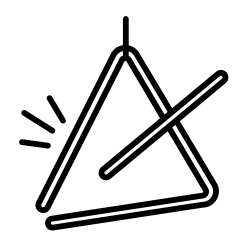
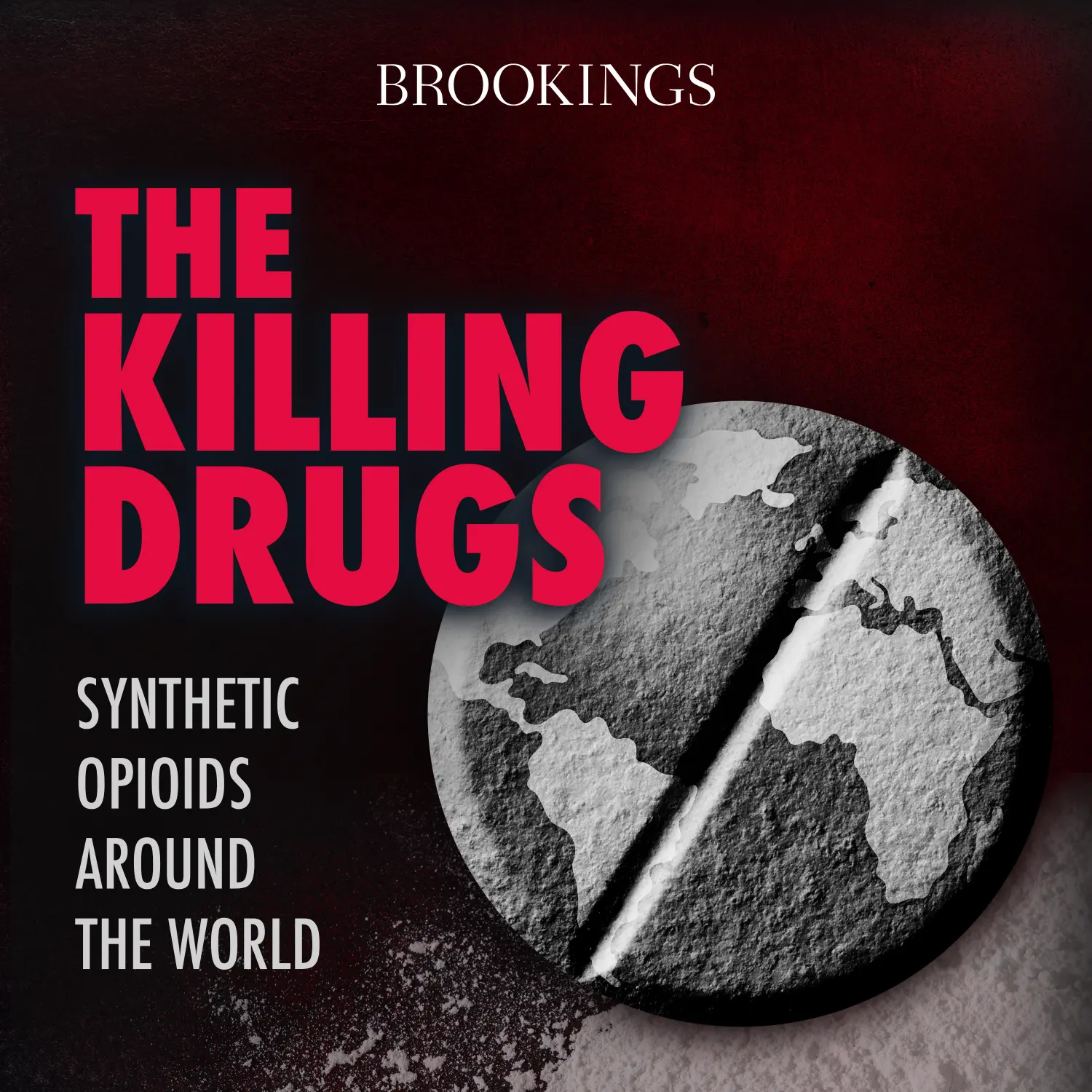
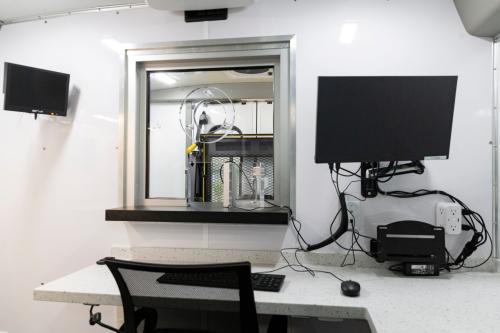




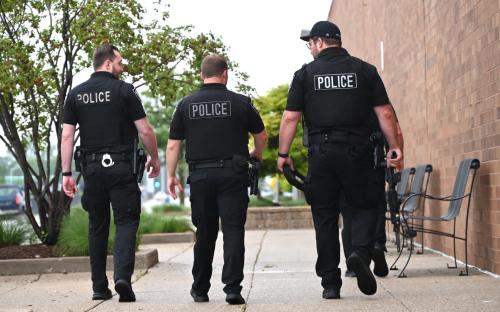
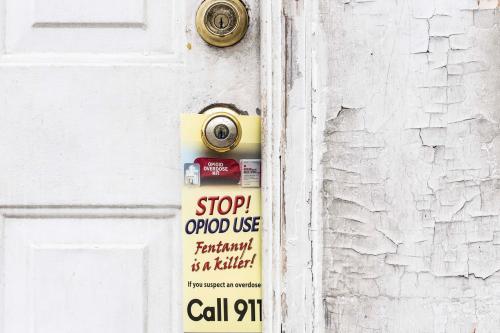
Commentary
PodcastBreaking barriers to opioid use disorder treatment
Listen on
The Killing Drugs: Synthetic Opioids around the World
August 27, 2024